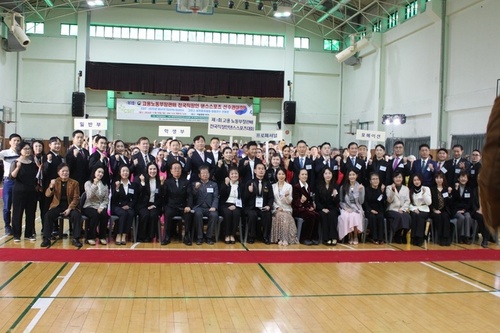|
로봇 '봇핏'은 장애인, 특히 이동이 불편한 이들에게 도움을 줄 수 있는 가능성 봇핏(Botfit)은 삼성전자가 개발한 최첨단 웨어러블 로봇 [장애인인식개선]삼성전자의 웨어러블 로봇봇핏(Botfit) 기대효과 분석로봇 '봇핏'은 장애인, 특히 이동이 불편한 이들에게 도움을 줄 수 있는 가능성
|
 ▲ [장애인인식개선]삼성전자의 웨어러블 로봇봇핏(Botfit) 기대효과 분석 © 장애인인식개선신문 |
[장애인인식개선칼럼] 장애인인식개선신문=최봉혁 칼럼 최근 삼성전자가 100만원 안팎의 웨어러블 로봇 '봇핏'을 출시 임박했다고 여러매체가 보도하고 있다.
로봇 '봇핏'은 장애인, 특히 이동이 불편한 이들에게 도움을 줄 수 있는 가능성에 대한 관심이 높아지고 있다.
이번 칼럼 에서는 장애인을 위한 유용성에 초점을 맞춰 Botfit의 기능, 이점, 제한 사항 및 향후 잠재력을 보도한다.
■ Botfit 개요 및 특징
봇핏(Botfit)은 삼성전자가 개발한 최첨단 웨어러블 로봇으로 보행 보조를 통해 이동성을 강화하도록 설계됐다.
주요 기능은 다음과 같다.
△워킹 어시스트: Botfit은 사용자의 다리에 부착되어 걷는 동안 생성되는 힘을 향상시켜 이동성이 제한된 개인에게 특히 유용합니다. 이 기능은 걷는 속도를 높이고 피로를 줄여 사용자가 보다 자유롭고 효율적으로 움직일 수 있도록 도와준다.
△맞춤화: 로봇은 사용자의 체형과 보행 패턴에 맞는 맞춤화 옵션을 제공하여 최적화되고 개인화된 경험을 보장한다. 이러한 적응성은 다양한 사용자의 고유한 요구 사항을 수용하는 데 중요하다.
△스마트폰 통합: Botfit은 스마트폰 앱을 통해 제어 및 모니터링할 수 있어 사용자가 편리하게 설정을 조정하고 운동 데이터를 추적할 수 있습니다. 이 기능은 실시간 피드백과 제어 용이성을 제공하여 사용자 경험을 향상시킵니다.
■ 장애인을 위한 Botfit의 이점
△이동성 향상: Botfit은 하반신 마비가 있는 사람이나 근육이 약한 노인과 같은 장애인의 이동성을 크게 향상시킬 수 있는 잠재력을 가지고 있다. 이 장치의 보행 보조 기능은 이러한 개인이 보다 자유롭고 자신감 있게 움직일 수 있도록 도와주므로 기존 이동 보조 기구에 대한 의존도를 줄일 수 있다.
△향상된 삶의 질: Botfit은 이동성을 개선함으로써 장애인의 사회적 참여를 확대하고 전반적인 삶의 질을 향상시킬 수 있다. 이동 시 독립성이 높아지면 사회적 참여, 업무 및 여가 활동을 위한 새로운 기회가 생겨 고립감과 의존성을 줄이는 데 도움이 된다.
△재활 혜택: Botfit은 재활을 위한 효과적인 도구 역할도 할 수 있습니다. 이를 사용하면 근육을 강화하고 관절 유연성을 향상시키며 통제된 방식으로 점진적인 회복을 지원함으로써 신체 재활을 받는 사용자에게 치료상의 이점을 제공할 수 있다. 일상적인 보조 도구이자 재활 도구인 이 이중 기능을 통해 Botfit은 다용도 솔루션이 될수있다.
■ Botfit의 단점과 한계
수많은 장점에도 불구하고 Botfit에는 광범위한 채택을 제한할 수 있는 몇 가지 단점이 있다.
△높은 가격: 약 100만원에 달하는 Botfit은 상당한 재정적 투자를 의미하며 이는 많은 잠재 사용자에게 장벽이 될 수 있습니다. 이러한 높은 비용은 접근성을 제한할 수 있으며, 특히 의료비 및 수입 능력 감소로 인해 이미 재정적 제약에 직면할 수 있는 장애인의 경우 더욱 그렇다.
△착용감 : 봇핏의 디자인으로 인해 장시간 착용시 불편함이 있을 수 있다. 일부 사용자는 장기간 사용하면 자극이나 피로를 유발할 수 있어 지속적인 사용을 방해할 수 있다고 보고했습니다. 장기적으로 채택하려면 장치가 편안하고 사용자 친화적인지 확인하는 것이 필수적이다.
△배터리 수명: Botfit의 배터리 수명은 자주 재충전하지 않으면 장기간 사용이 제한되기 때문에 또 다른 문제이다. 하루 종일 장치에 의존하는 사용자의 경우 정기적으로 재충전해야 하는 필요성이 불편할 수 있으며 일상 활동에 대한 실제 적용을 방해할 수 있다.
△보험 적용 범위 제한: 현재 Botfit과 같은 웨어러블 로봇은 건강 보험의 적용을 받지 않는다. 즉, 사용자가 전체 비용을 직접 부담해야 한다. 이러한 보험 적용 범위 부족으로 인해 재정적 부담이 더욱 악화되고, 기술로부터 가장 큰 혜택을 받을 수 있는 사람들의 접근성이 제한된다.
■ Botfit의 현실적인 대안과 향후 방향
Botfit은 장애인에게 유망한 이점을 제공하지만 높은 비용과 실질적인 한계로 인해 추가 개발 및 지원이 필요하다. 여러 전략을 통해 Botfit의 접근성과 실용성을 향상할 수 있다.
△가격 인하: 정부 보조금을 도입하거나 기업의 사회적 책임 이니셔티브를 장려하면 Botfit의 비용을 절감하여 더 많은 사용자가 더 저렴하게 사용할 수 있다.
△향상된 핏과 편안함: 핏과 편안함을 개선하기 위해 디자인을 강화하면 더 오랫동안 사용할 수 있도록 장려하고 사용자 만족도를 높일 수 있다. 인체공학적 디자인과 사용자 피드백에 대한 집중적인 연구는 이 분야에서 상당한 개선을 가져올 수 있다.
△보험 적용 범위 확대: Botfit과 같은 웨어러블 로봇을 건강 보험에 포함하면 사용자의 재정적 부담을 크게 줄여 채택을 더욱 확대할 수 있다. 이를 달성하려면 옹호와 정책 변화가 핵심이 될 것이다.
△렌탈 시스템 구축: Botfit을 위한 렌탈 모델 개발은 기기를 직접 구매할 여유가 없는 사용자에게 비용 효율적인 대안을 제공할 수 있습니다. 이러한 접근 방식은 진입 장벽을 낮추고 더 많은 사람들이 기술에 접근할 수 있게 만들 것이다.
■ 미래 비전: AI 기반 로봇 의류와 그 잠재력
Botfit과 같은 웨어러블 로봇의 개발은 빠르게 진행되고 있으며, 인공지능(AI) 기술의 통합은 더욱 스마트하고 다양한 보조 장치를 약속합니다. 미래의 AI 기반 로봇 의류는 보행 보조를 넘어 다음과 같은 다양한 기능을 제공할 수 있다.
△건강 모니터링: 지속적인 건강 모니터링과 데이터 수집은 사용자의 신체 상태에 대한 귀중한 통찰력을 제공하여 시기적절한 의료 개입과 맞춤형 의료 전략을 가능하게 한다.
△맞춤형 운동 프로그램: AI 알고리즘은 사용자의 건강 데이터 및 피트니스 목표를 기반으로 운동 요법을 맞춤화하여 Botfit과 같은 웨어러블 로봇의 재활 잠재력을 더욱 향상시킬 수 있다. 이러한 개인화된 접근 방식은 결과를 최적화하고 사용자 참여를 향상시킬 수 있다.
△고급 안전 기능: 고급 AI 기능을 통합하면 다양한 환경에서 낙상 및 기타 사고를 예측하고 예방하여 사용자를 안전하게 지킬 수 있다. 이러한 안전 강화는 사용자와 간병인에게 마음의 평화를 제공하고 보다 독립적인 생활을 촉진할 것이다.
삼성전자의 Botfit은 장애인을 위한 웨어러블 기술의 획기적인 발전을 나타내며 이동성, 재활 및 삶의 질 측면에서 수많은 이점을 제공한다. 그러나 접근성과 유용성을 향상하려면 높은 비용, 제한된 편의성, 배터리 수명, 보험 보장 등의 과제를 해결해야 한다.
지속적인 혁신, 정책 지원, 사용자 중심 설계 개선을 통해 Botfit과 같은 웨어러블 로봇은 삶을 변화시키고 장애인의 사회 참여와 독립성을 높일 수 있는 잠재력을 가지고 있다.
경력
(ESG·RE100·DX· AI 융복합 전문가, 직장내 장애인인식개선교육전문가)
한국AI.ESG교육협회 부회장
한국구매조달학회 이사
한국언론정보기술협회 이사
스포츠피플타임즈 발행인
장애인인식개선신문 발행인
한국장애인문화예술단체총연합회
문화예술정잭위원회 부위원장
직장내 장애인인식개선 전문강사
• 스포츠피플타임즈 대표
• 장애인인식개선신문사 대표
• 최봉혁기자의 파워블로그만들기 기획연재 2020 ~ 2023
• 최봉혁 기자의 가상화폐엿보기 기획연재 2021 ~ 2023
• 한국AI·ESG교육협회 부회장
• 한국인공지능메타버스연구원 상임부회장
• 한국구매조달학회 (이사. 기획위원장)
저서
•아침 안개 속의 아메리카노 속삭임 -Coffee Essay
•장애인인식개선칼럼-ESG경영-장애인포용정책
• 2024비트코인전망과 팩트첵크
• 2024 후반기 비트코인전망
• AI예언 - 2024 베스트 13가지 AI 트랜드 전망
• 경남발달장애작가특별전 에세이
• ESG경영칼럼
• 한미 민간외교의 숨은주역 박동우 미오바마 행정부 장애정책 차관보
• 유연함의 큐브 - 임정은 작가 최봉혁 에세이
• ESG.RE100 경영칼럼
• 어둠을 뚫고 새벽을 열다 (기획출판)
===================================================
Samsung Electronics' Wearable Robot Botfit: Comprehensive Analysis for People with Disabilities
With the recent launch of Samsung Electronics' wearable robot 'Botfit,' priced at around 1 million won (approximately $1,000), there is growing interest in its potential to assist people with disabilities, particularly those who have difficulty with mobility. This analysis will explore Botfit's features, benefits, limitations, and its future potential, focusing on its usability for people with disabilities.
Overview and Features of Botfit
Botfit is a state-of-the-art wearable robot developed by Samsung Electronics, designed to enhance mobility through walking assistance. Its key features include:
Walking Assist: Botfit attaches to the user's legs and enhances the force generated while walking, making it particularly beneficial for individuals with limited mobility. This feature helps increase walking speed and reduces fatigue, enabling users to move more freely and efficiently.
Customization: The robot offers customization options tailored to the user's body type and walking pattern, ensuring an optimized and personalized experience. This adaptability is crucial for accommodating the unique needs of different users.
Smartphone Integration: Botfit can be controlled and monitored via a smartphone app, allowing users to adjust settings and track exercise data conveniently. This feature enhances the user experience by providing real-time feedback and ease of control.
Benefits of Botfit for People with Disabilities
Improved Mobility: Botfit has the potential to significantly improve the mobility of people with disabilities, such as those with paraplegia or older adults with muscle weakness. The device's walking assistance function can help these individuals move more freely and confidently, reducing reliance on traditional mobility aids.
Enhanced Quality of Life: By improving mobility, Botfit can expand social participation for people with disabilities, enhancing their overall quality of life. Greater independence in movement can lead to new opportunities for social engagement, work, and leisure activities, helping to reduce feelings of isolation and dependency.
Rehabilitation Benefits: Botfit can also serve as an effective tool for rehabilitation. Its use can provide therapeutic benefits to users undergoing physical rehabilitation by helping to strengthen muscles, improve joint flexibility, and support gradual recovery in a controlled manner. This dual functionality—both as an everyday aid and a rehabilitation tool—makes Botfit a versatile solution.
Disadvantages and Limitations of Botfit
Despite its numerous advantages, Botfit does have some drawbacks that may limit its widespread adoption:
High Price: At around 1 million won, Botfit represents a significant financial investment, which may be a barrier for many potential users. This high cost could limit accessibility, especially for individuals with disabilities who may already face financial constraints due to medical expenses and reduced earning capacity.
Wearing Comfort: The design of Botfit may cause discomfort when worn for extended periods. Some users have reported that prolonged use can lead to irritation or fatigue, which may discourage continuous use. Ensuring the device is comfortable and user-friendly is essential for long-term adoption.
Battery Life: Botfit's battery life is another concern, as it limits long-term use without frequent recharging. For users who rely on the device throughout the day, the need to recharge regularly can be inconvenient and may hinder its practical application for daily activities.
Insurance Coverage Limitations: Currently, wearable robots like Botfit are not widely covered by health insurance, meaning users must bear the full cost themselves. This lack of insurance coverage further exacerbates the financial burden, limiting accessibility for those who could benefit most from the technology.
Realistic Alternatives and Future Directions for Botfit
While Botfit offers promising benefits for people with disabilities, its high cost and practical limitations suggest a need for further development and support. Several strategies could enhance Botfit's accessibility and practicality:
Price Reduction: Introducing government subsidies or encouraging corporate social responsibility initiatives could help reduce the cost of Botfit, making it more affordable for a broader range of users.
Improved Fit and Comfort: Enhancing the design to improve fit and comfort would encourage longer use and increase user satisfaction. Focused research on ergonomic design and user feedback could lead to significant improvements in this area.
Expanded Insurance Coverage: Including wearable robots like Botfit in health insurance plans could significantly reduce the financial burden on users, encouraging more widespread adoption. Advocacy and policy changes will be key to achieving this.
Establishment of a Rental System: Developing a rental model for Botfit could provide a cost-effective alternative for users who cannot afford to purchase the device outright. This approach would lower the entry barrier and make the technology accessible to more people.
Future Vision: AI-Driven Robot Clothing and Its Potential
The development of wearable robots like Botfit is progressing rapidly, and integrating artificial intelligence (AI) technology holds the promise of even smarter and more versatile assistive devices. Future AI-driven robotic garments could offer a range of functions beyond walking assistance, including:
Health Monitoring: Continuous health monitoring and data collection could provide valuable insights into the user's physical condition, enabling timely medical interventions and personalized healthcare strategies.
Personalized Exercise Programs: AI algorithms could tailor exercise regimens based on the user's health data and fitness goals, further enhancing the rehabilitative potential of wearable robots like Botfit. This personalized approach could optimize outcomes and improve user engagement.
Advanced Safety Features: Incorporating advanced AI features could help keep users safe by predicting and preventing falls and other accidents in various environments. These safety enhancements would provide peace of mind for users and their caregivers, promoting more independent living.
Conclusion
Samsung Electronics' Botfit represents a significant advancement in wearable technology for people with disabilities, offering numerous benefits in terms of mobility, rehabilitation, and quality of life. However, challenges such as high cost, limited comfort, battery life, and insurance coverage need to be addressed to enhance its accessibility and usability. With continued innovation, policy support, and user-centered design improvements, wearable robots like Botfit have the potential to transform lives, fostering greater independence and participation in society for people with disabilities.
<저작권자 ⓒ 장애인인식개선신문 무단전재 및 재배포 금지>

댓글
많이 본 기사
























